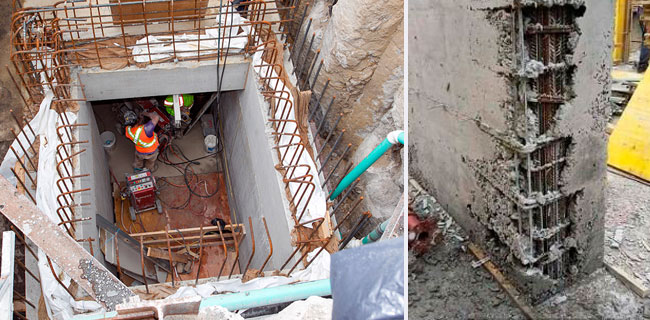
7 kinds of Construction failings in Reinforced Concrete Structures

There can be happen several concrete defects in Reinforced Concrete structures which lead the concrete structures weak and make the building defective.
Concrete is a popular building material which often known for its toughness; Concrete is made up with three basic things which are: water, aggregate (rock, sand or gravel) and Portland cement. It is known as a very versatile and reliable material though some construction faults and imprudence can lead to the growth of defects in a concrete structure. These failings can be seen as per poor construction practices, poor quality control or for poor structural design and detailing.
In this article we will discuss about some known defects in concrete structures and the types are written here:
1. Honeycomb and Rock Pockets: This kind of defect can be seen on the concrete structure where gaps are left for the failure of cement mortar to pour spaces around and among coarse aggregates. It happens when poor quality control is mixed during mixing; transporting; or laying of concrete, under or over-compression of concrete, lack of space between bars and low cement content or improper mix design. This kind of defect may reduce durability and make the concrete weak; but if they are minor can be repaired by cement mortar within 24 hours or it can?t be repaired.
2. Poor Formwork Installation: This error includes misalignment, movement, and loss of support, failure of forms which can be lead to cracking and structural failure. The loss of support during construction can increase settlement cracks; while insufficient formwork support and premature removal of formwork are main reasons of loss of support in the construction. These errors can be repaired with surface grinding to maintain the prop of the structure if the error is minor; for major errors, it shall be repaired by removing the concrete in defective area and then building that portion again.
3. Concrete Dimensional Errors: These errors happen when there is poor entering of a structural member or for deviation from the specifications.
4. Finishing Errors: They include over-finishing of the concrete surface or addition of more water or cement to the surface while finishing of the concrete which makes the concrete permeable and makes concrete less durable.
5. Shrinkage Cracks: It happens due to the evaporation of water from the concrete mixture; the intensity of this problem is depended on some reasons like the amount of water in concrete, weather conditions and curing regime.
6. Poor Reinforcement Placement: Defects during reinforcement installation can cause serious concrete deterioration; also insufficient chair bars and lack of tying of reinforcement would cause rebar movement which may cause to insufficient concrete cover and reduction in effect depth of the concrete section. As a result, the durability of the concrete structure is compromised and the structure would be exposed to chemical attacks.
7. Bugholes: Bugholes or surface voids are small regular or irregular cavities made due to the entrapment of air bubbles in the surface during placement and consolidation. They commonly found in vertical cast-in-place concrete like walls and columns. Both the size and number of bugholes vary and depend on form-facing material and condition, release-agent type and application thickness, concrete mix characteristics and placement and consolidation practices.
Source www.theconstructor.org


